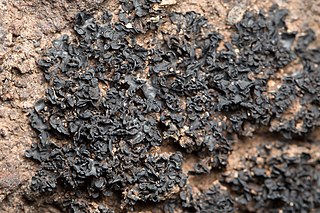
Gloeoheppiaceae is a family of ascomycete fungi in the order Lichinales. The family contains ten species distributed amongst three genera. Most species are lichenised with cyanobacteria. Species in this family are mostly found in desert areas. Modern molecular phylogenetics analysis casts doubt on the phylogenetic validity of the family, suggesting a more appropriate placement of its species in the family Lichinaceae.

The Lichinaceae are a family of ascomycete fungi. Most species are lichenized with cyanobacteria, and have a distribution largely in temperate regions.
Edwardiella is a genus of fungi within the family Lichinaceae. This is a monotypic genus, containing the single species Edwardiella mirabilis. Aino Henssen named the genus after the Prince Edward Islands, the type locality of the type species.

Lempholemma is a genus of lichen-forming fungi in the family Lichinaceae.

Lichinella is a genus of lichen-forming fungi in the family Lichinaceae. It was circumscribed in 1872 by Finnish lichenologist William Nylander. Five species are accepted by Species Fungorum.
Lichinodium is a genus of filamentous lichens. It is the only genus in the family Lichinodiaceae, itself the only member of the order Lichinodiales. Lichinodium has four species. Previously considered part of the class Lichinomycetes, molecular phylogenetic analysis revealed that Lichinodium represents a unique lineage in the Leotiomycetes—the first known group of lichen-forming fungi in this class.
Pterygiopsis is a genus of fungi within the family Lichinaceae. It contains 11 species.

Pyrenopsis is a genus of lichen-forming fungi in the family Lichinaceae. It contains 12 species. The genus was circumscribed by the Finnish lichenologist William Nylander in 1858.
Stromatella bermudana is a saxicolous (rock-dwelling) crustose lichen. It is the only species in Stromatella, a monotypic fungal genus in the family Lichinaceae.
Zahlbrucknerella is a genus of filamentous, rock-dwelling lichens in the family Lichinaceae.

Thyrea is a genus of lichen-forming fungi in the family Lichinaceae. It contains four species that have been accepted by Species Fungorum. The genus was circumscribed by Italian lichenologist Abramo Bartolommeo Massalongo in 1856, with Thyrea plectospora assigned as the type species.
Staurolemma is a genus of lichenized fungi in the family Pannariaceae. The genus was circumscribed by German lichenologist Gustav Wilhelm Körber in 1867, with Staurolemma dalmaticum as the type species.
Aino Marjatta Henssen, was a German lichenologist and systematist. Her father, Gottfried Henssen, was a folklorist and her mother was Finnish.
Lichinodium ahlneri is a species of filamentous lichen belonging to the family Lichinodiaceae. Described as a new species in 1963 by Aino Henssen, the specific epithet honours Swedish lichenologist Sten Ahlner.

Roccellinastrum is a genus of lichen-forming fungi in the family Pilocarpaceae. It has seven species.
Harpidiaceae is a small family of lichen-forming fungi, containing two genera and five species. It is of uncertain classification in the Pezizomycotina.
Degelia neozelandica is a species of foliose lichen in the genus Degelia.

Gloeoheppia is a genus of lichen-forming fungi in the family Gloeoheppiaceae. It comprises five species. The genus is distinguished from similar-looking lichens like Heppia by its internal structure, the nature of its photobiont, and details of its reproductive structures.
Metamelanea is a small genus of lichen-forming fungi in the family Lichinaceae. It consists of three species of rock-dwelling lichens.
Pseudopeltula is a genus of lichen-forming fungi in the family Gloeoheppiaceae. Established in 1995 by the lichenologist Aino Henssen, the genus currently includes four recognised species. These small cyanolichens are characterised by their squamulose (scaly) to peltate (shield-shaped) thalli, which lack a lower cortex and are attached to the substrate by rhizines. A key feature of Pseudopeltula is its complex apothecia, which have hymenia that often become divided by sterile tissue as they mature. The genus is primarily found in arid and semi-arid regions of North America, Mexico, and the Caribbean, where species typically grow on soil, rock, or thin soil over rock, often forming part of biological soil crusts in desert environments.






